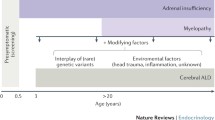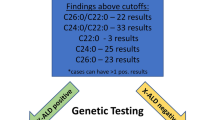Abstract
X-linked adrenoleukodystrophy (X-ALD) is an inherited disorder of peroxisomal metabolism, biochemically characterized by deficient β-oxidation of saturated very long chain fatty acids (VLCFA). The consequent accumulation of these fatty acids in different tissues and in biological fluids is associated with a progressive central and peripheral demyelination, as well as with adrenocortical insufficiency and hypogonadism. Seven variants of this disease have been described, being cerebral childhood the most frequent. The recommended therapy consists of the use of the glyceroltrioleate/glyceroltrierucate mixture known as Lorenzo’s Oil (LO), combined with a VLCFA-poor diet, but only in asymptomatic patients will this treatment prevent the progression of the symptomatology. In the present study we evaluated the biochemical course of patients with cerebral childhood (CCER) and asymptomatic clinical forms of X-ALD treated with LO associated with a VLCFA-restricted diet. We observed that hexacosanoic acid plasma concentrations and hexacosanoic/docosanoic ratio were significantly reduced in CCER patients during treatment when compared with diagnosis. Hexacosanoic acid plasma level was significantly reduced when compared with that at diagnosis and achieved the normal levels only in asymptomatic patients under LO treatment. In asymptomatic patients the magnitude of hexacosanoic acid decrease was higher than that of the CCER patients. These results show the good biochemical response of LO treatment in asymptomatic X-ALD patients. It is possible to suppose that this could be correlated with the prevention of the appearance of neurological signals in this group of patients treated with LO.


Similar content being viewed by others
References
Altman DG (1991) Practical Statistics for Medical Research. Chapman & Hall, London
Dubey P, Raymond GV, Moser AB, Kharkar S, Bezman L, Moser HW (2005) Adrenal insufficiency in asymptomatic adrenoleucodystrophy patients identified by very long chain fatty acid screening. J Pediatr 146(4):528–32
Korenke GC, Hunneman DH, Kohler J, Stöckler S, Landmark K, Hanefeld F (1995) Glyceroltrioleato/glyceroltrierucate therapy in 16 patients with X-chromosomal adrenoleukodystrophy/adrenomyeloneuropathy: effect on clinical, biochemical and neurophysiological parameters. Eur J Pediatr 154:64–70
Mahmood A, Dubey P, Moser HW, Moser A (2005) X-linked adrenoleukodystrophy: therapeutic approaches to distinct phenotypes. Pediatr Transplantation 9(7):55–62
Moser HW (1997) Adrenoleukodystrophy: phenotype, genetics, pathogenesis and therapy. Brain 120:1485–1508
Moser HW (2006) Therapy of X-linked Adrenoleukodystrophy. NeuroRx 3:246–253
Moser HW, Moser AB (1991) Measurement of saturated very long chain fatty acid in plasma. In: Hommes FA (ed) Techniques of diagnostic human biochemical genetics. Wiley, New York
Moser HW, Smith KD, Watkins PA, Powers J, Moser AB (2001) X-linked adrenoleukodystrophy. In: Scriver CR, Beaudet AL, Sly WS, Valle D (eds) The metabolic and molecular bases of inherited disease. 8th edn. McGraw-Hill, New York
Moser HW, Dubey P, Fatemi A (2004) Progress in X-linked adrenoleukodystrophy. Curr Opin Neurol 17:263–269
Moser HW, Raymond GV, Lu SE, Muenz LR, Moser AB, Xu J, Jones RO, Loes DJ, Melhem ER, Dubey P, Bezman L, Brereton NH, Odone A (2005) Follow-up of 89 asymptomatic patients with adrenoleukodystrophy treated with Lorenzo’s oil. Arch Neurol 62(7):1073–80
Restuccia D, Di Lazzaro V, Valeriani M, Oliviero A, Le Pera D, Barba C, Cppa M, Bertini E, Di Capua M, Tonali P (1999) Neurophysiologic follow-up of long-term dietary treatment in adult-onset adrenoleukodystrophy. Neurology 52:810–815
Ruiz M, Pampols T, Girós M (1996) Glycerol trioleato/glycerol trierucate therapy in X-linked adrenoleukodystrophy: Saturated and unsaturated fatty acids in blood cells. Implications for the follow-up. J Inher Metab Dis 19:188–192
Suzuki Y, Imamura A, Shimozawa N, Kondo N (2001) The clinical course of childhood and adolescent adrenoleukodystrophy before and after Lorenzo’s oil. Brain Dev 23(1):30–3
van Geel BM, Assies J, Wanders RJA, Barth PG (1997) X-linked adrenoleukodystrophy: clinical, presentation, diagnosis and therapy. J Neurol Neurosurg Psychiatry 63:4–14
van Geel BM, Assies J, Haverkort EB, Koelman JHTM, Verbeeten B Jr, Wander RJA, Barth PG (1999) Progression of abnormalities in adrenomyeloneuropathy and neurologically asymptomatic X-linked adrenoleukodystrophy despite treatment with Lorenzo’s oil. J Neurol Neurosurg Psychiatr 67(3):290–299
Acknowledgment
This research was supported by grants from CAPES, CNPq, FAPERGS, PROPESQ/UFRGS and FIPE/HCPA.
Author information
Authors and Affiliations
Corresponding author
Rights and permissions
About this article
Cite this article
Deon, M., Garcia, M.P., Sitta, A. et al. Hexacosanoic and docosanoic acids plasma levels in patients with cerebral childhood and asymptomatic X-linked adrenoleukodystrophy: Lorenzo’s oil effect. Metab Brain Dis 23, 43–49 (2008). https://doi.org/10.1007/s11011-007-9079-9
Received:
Accepted:
Published:
Issue Date:
DOI: https://doi.org/10.1007/s11011-007-9079-9




